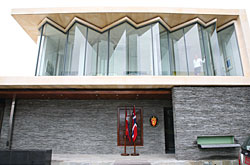 MIN RATNA BAJRACHARYA |
Large zig-zag windows dominate the low-slung fa?ade of the building that you don't see until you are right in front of it. The building is classic Nordic architectural functionality, low-key and modern, and full of common sense.
"We call them the Himalayan windows," says architect Kristin Jarmund, who designed the building and its dramatic glass fa?ade, "the windows mimic the mountains, and when the weather is clear it will reflect Langtang."
The building was inaugurated on Monday by visiting Norwegian Development Minister Erik Solheim. "It is a fantastic coincidence that this chancery is being opened on the day of the prime minister's oath-taking," said Solheim at the inaugural function attended by Nepali foreign ministry officials and Kathmandu-based diplomats.
Solheim was the first foreign dignitary to visit Nepal after the success of the People Power uprising in April 2006, and couldn't help drawing attention to Nepal's political transformation since then. "This is the first time in world history that a Maoist has been elected to head a government," he said, "even Mao wouldn't have predicted it."
The chancery building in Kopundole has used local materials as much as possible. "This is not Norwegian wood," says Jarmund (see in pic, left) pointing out the sisau ceiling and wall panels. Stacked slate facades and flagstones in the parking lot and walls are all locally made.
This is the first foreign project for Jarmund's firm, which has designed school buildings, office blocks and even tube stations in Norway. Three years ago when she saw the site for the first time, it was north-facing terraced slope in Kopundole with a view of the mountains.
"What we tried to do was to greet and celebrate the Himalayan environment and integrate the building with the outside," she says.
In stark contrast with the elegant functionality of the building, however, are the unaesthetic brick-and-concrete boxes that have come up outside the compound in the three years it took for the embassy to be completed.
Nepali architects could learn a tip or two from a building that is stylishly simple and built mostly from material available in Nepal. The building is also energy efficient and environment-friendly, with a rainwater harvesting system and solar heating panels.
Norwegian ambassador Tore Toreng said he was happy everything had come together a week before he is scheduled to conclude his four-year tenure in Nepal. He told guests at Monday's inauguration: "I managed to see the building finished before I go, and even got to see the new prime minister take office."


